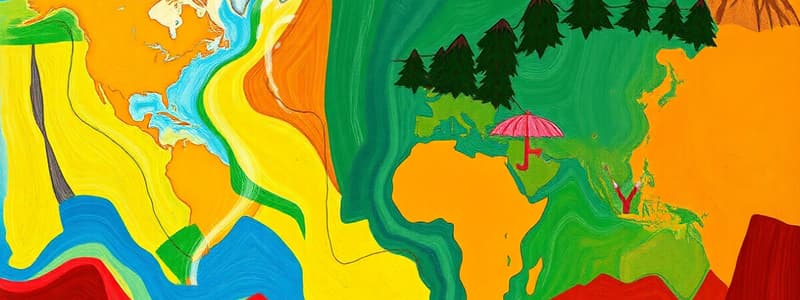Podcast
Questions and Answers
What is the primary focus of Human Geography?
What is the primary focus of Human Geography?
- Climate and weather patterns
- Human behavior and its relationship with the environment (correct)
- Study of landforms and their processes
- Natural features and processes
Which component of Physical Geography deals with the study of climates?
Which component of Physical Geography deals with the study of climates?
- Climatology (correct)
- Geomorphology
- Hydrology
- Biogeography
What type of map would you use to understand population density in a region?
What type of map would you use to understand population density in a region?
- Topographic Map
- Thematic Map (correct)
- Political Map
- Physical Map
Which term best describes the unique characteristics of a specific location?
Which term best describes the unique characteristics of a specific location?
What does GIS stand for in geography, and what is its purpose?
What does GIS stand for in geography, and what is its purpose?
Which of the following is an example of Human-Environment Interaction?
Which of the following is an example of Human-Environment Interaction?
What is defined as the exact coordinates used to determine a location on Earth?
What is defined as the exact coordinates used to determine a location on Earth?
Which branch of geography primarily studies landforms and their processes?
Which branch of geography primarily studies landforms and their processes?
Flashcards are hidden until you start studying
Study Notes
Definition of Geography
- Study of the Earth's landscapes, environments, and the relationships between people and their environments.
- Divided into two main branches: Physical Geography and Human Geography.
Physical Geography
- Focuses on natural features and processes:
- Landforms
- Climate and weather patterns
- Ecosystems and biomes
- Natural resources (water, minerals, vegetation)
- Key Components:
- Geomorphology: Study of landforms and their processes.
- Climatology: Study of climates and their impact on environments.
- Hydrology: Study of water in the environment.
Human Geography
- Examines human behavior and its relationship with the environment:
- Population distribution and demographics
- Cultural landscapes (religions, languages, traditions)
- Economic activities (industry, agriculture, trade)
- Urban development and planning
- Key Topics:
- Political Geography: Influence of politics on space and territory.
- Cultural Geography: Exploration of cultural norms and practices in different areas.
Geographic Information Systems (GIS)
- Tools for mapping and analyzing spatial data.
- Used in various applications:
- Urban planning
- Environmental management
- Transportation networks
- Disaster response
Map Types
- Physical Maps: Display natural features like mountains, rivers.
- Political Maps: Show boundaries, countries, cities.
- Thematic Maps: Focus on specific themes (e.g., population density, climate).
Major Geographic Concepts
- Location: Defines where something is situated.
- Absolute Location: Exact coordinates (latitude and longitude).
- Relative Location: Position related to other locations.
- Place: Characteristics that make a location unique.
- Region: Areas defined by common features (cultural, economic).
- Movement: How and why people, goods, and ideas move from one place to another.
- Human-Environment Interaction: How humans adapt to and modify their environments.
Key Terms
- Topography: The arrangement of natural and artificial physical features on the surface of the earth.
- Latitude and Longitude: Coordinate system used to determine locations on Earth.
- Ecosystem: A community of living organisms and their physical environment interacting as a system.
Importance of Geography
- Understanding spatial relationships helps in addressing global issues such as:
- Climate change
- Urbanization
- Resource management
- Provides insights into cultural diversity and development patterns.
Geography: The Study of Earth and its People
- Geography encompasses the study of the Earth's landscapes, environments, and the relationships between people and their environments.
- It is divided into two main branches: Physical Geography and Human Geography.
Physical Geography
-
Physical Geography focuses on natural features and processes, including:
- Landforms: Mountains, valleys, rivers, and other physical features of the Earth's surface
- Climate and Weather Patterns: Long-term and short-term atmospheric conditions impacting environments
- Ecosystems and Biomes: Communities of living organisms and their physical environments
- Natural Resources: Water, minerals, and vegetation essential for human survival and development
-
Key areas of study within physical geography:
- Geomorphology: The study of landforms and their formation processes
- Climatology: The study of climates and their impact on environments
- Hydrology: The study of water in the environment, its movement, and distribution
Human Geography
-
Human Geography examines how human behavior interacts with the environment, including:
- Population Distribution and Demographics: The spatial patterns and characteristics of human populations
- Cultural Landscapes: The imprint of human cultures on the environment, such as religions, languages, and traditions
- Economic Activities: Industries, agriculture, trade, and other human activities shaping the landscape
- Urban Development and Planning: The growth of cities and their impact on the environment
-
Key topics within human geography:
- Political Geography: The influence of politics on space and territory
- Cultural Geography: The exploration of cultural norms and practices in different areas
Geographic Information Systems (GIS)
- GIS are tools used for mapping and analyzing spatial data.
- They are crucial for applications including:
- Urban planning: Designing efficient and sustainable cities
- Environmental management: Protecting natural resources and ecosystems
- Transportation networks: Optimizing movement of people and goods
- Disaster response: Coordinating relief efforts and assessing damage
Map Types
- Physical Maps: Display natural features like mountains, rivers, and elevation
- Political Maps: Show boundaries, countries, cities, and political divisions
- Thematic Maps: Focus on specific themes like:
- Population density
- Climate patterns
- Resource distribution
Major Geographic Concepts
- Location: Defines where something is situated:
- Absolute Location: Exact coordinates using latitude and longitude
- Relative Location: Position in relation to other locations
- Place: Unique characteristics of a location, making it distinct from others
- Region: Areas defined by common features, such as:
- Cultural similarities
- Economic activities
- Climate conditions
- Movement: The flow of people, goods, and ideas across space
- Human-Environment Interaction: How humans adapt to and modify their environments
Key Terms
- Topography: The arrangement of natural and artificial physical features of the Earth's surface
- Latitude and Longitude: A coordinate system used to locate points on Earth
- Ecosystem: A community of living organisms and their physical environment interacting as a system
Importance of Geography
- Understanding spatial relationships is crucial for addressing global issues:
- Climate Change: Understanding environmental patterns and their impact on different regions
- Urbanization: Managing the growth of cities and its effect on resources and infrastructure
- Resource Management: Managing natural resources sustainably
- Geography helps us understand:
- Cultural Diversity: The different ways people live and interact with the environment
- Development Patterns: The spatial distribution of wealth, poverty, and development across the globe
Studying That Suits You
Use AI to generate personalized quizzes and flashcards to suit your learning preferences.




